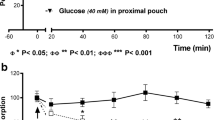Summary
This study was performed to examine the metabolism and absorption of intragastrically administered capsaicinoids in the anaesthetized rat.
[3H]-dihydrocapsaicin ([3H]-DHC) and unlabelled capsaicin were readily absorbed from the gastrointestinal tract but were almost completely metabolized before reaching the general circulation. A certain degree of biotransformation already took place in the intestinal lumen. Unchanged compounds (identified by chromatography) were present in portal vein blood. There seems to be a saturable absorption and degradation process in the gastrointestinal tract and a very effective metabolism in the liver.
Less than 5% of the total amount of extracted radioactivity consisted of unchanged [3H]-DHC in trunk blood and brain 15 min after gastrointestinal application. On the other hand, approximately 50% unchanged [3H]-DHC was detected in these tissues 3 min after i.v. or 90 min after s.c. application of the capsaicinoids. Dihydrocapsaicin (DHC) or [3H]-DHC were metabolized when incubated in vitro with liver tissue but not with brain tissue. The metabolic product(s) did not show capsaicin-like biological activity.
It can be concluded that rapid hepatic metabolization limits systemic pharmacological effects of enterally absorbed capsaicin.
Similar content being viewed by others
References
Amann R, Lembeck F (1986) Capsaicin sensitive afferent neurons from peripheral glucose receptors mediate the insulin-induced increase in adrenaline secretion. Naunyn-Schmiedeberg's Arch Pharmacol 334:71–76
Buck SH, Miller MS, Burks TF (1982) Depletion of primary afferent substance P by capsaicin and dihydrocapsaicin without altered thermal sensitivity. Brain Res 233:216–220
Donnerer J, Lembeck F (1983) Capsaicin-induced reflex fall in rat blood pressure is mediated by afferent substance P-containing neurones via a reflex centre in the brain stem. Naunyn-Schmiedeberg's Arch Pharmacol 324:293–295
Holzer P, Lippe IT (1988) Stimulation of afferent nerve endings by intragastric capsaicin protects against ethanol-induced damage of gastric mucosa. Neuroscience 27:981–987
Holzer P, Pabst MA, Lippe IT (1989) Intragastric capsaicin protects against aspirin-induced lesion formation and bleeding in the rat gastric mucosa. Gastroenterology 96:1425–1433
Kawada T, Iwai K (1985) In vivo and in vitro metabolism of dihydrocapsaicin, a pungent principle of hot pepper, in rats. Agric Biol Chem 49:441–448
Kawada T, Suzuki T, Takahashi M, Iwai K (1984) Gastroinstestinal absorption and metabolism of capsaicin and dihydrocapsaicin in rats. Toxicol Appl Pharmacol 72:449–456
Lippe IT, Pabst MA, Holzer P (1989) Intragastric capsaicin enhances rat gastric acid elimination and mucosal blood flow by afferent nerve stimulation. Br J Pharmacol 96:91–100
Lembeck F (1987) Columbus, capsicum and capsaicin: past, present and future. Acta Physiol Hung 69:265–273
Miller MS, Brendel K, Burks TF, Sipes IG (1983) Interactions of capsaicinoids with drug-metabolizing systems. Biochem Pharmacol 32:547–551
Niijima A (1982) Glucose-sensitive afferent nerve fibres in the hepatic branch of the vagus nerve in the guinea-pig. J Physiol 332:315–323
Santicioli P, Patacchini R, Maggi CA, Meli A (1987) Exposure to calcium free medium protects sensory fibers by capsaicin desensitization. Neurosci Lett 80:167–172
Saria A, Lembeck F, Skofitsch G (1981) Determination of capsaicin in tissues and separation of capsaicin analogues by high-performance liquid chromatography. J Chromatogr 208:41–46
Saria A, Skofitsch G, Lembeck F (1982) Distribution of capsaicin in rat tissues after systemic administration. J Pharm Pharmacol 34:273–275
Stoppini L, Barja F, Mathison R, Baertschi J (1984) Spinal substance P transmits bradykinin but not osmotic stimuli from hepatic portal vein to hypothalamus in rat. Neuroscience 11:903–912
Author information
Authors and Affiliations
Additional information
Send offprint requests to J. Donnerer at the above address
Rights and permissions
About this article
Cite this article
Donnerer, J., Amann, R., Schuligoi, R. et al. Absorption and metabolism of capsaicinoids following intragastric administration in rats. Naunyn-Schmiedeberg's Arch Pharmacol 342, 357–361 (1990). https://doi.org/10.1007/BF00169449
Received:
Accepted:
Issue Date:
DOI: https://doi.org/10.1007/BF00169449




